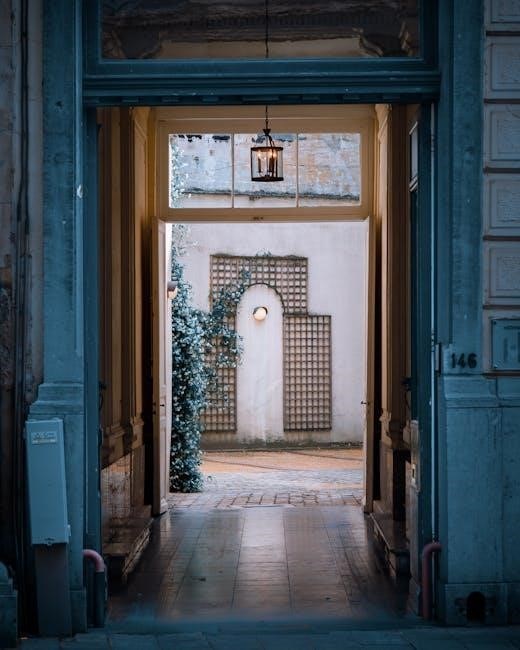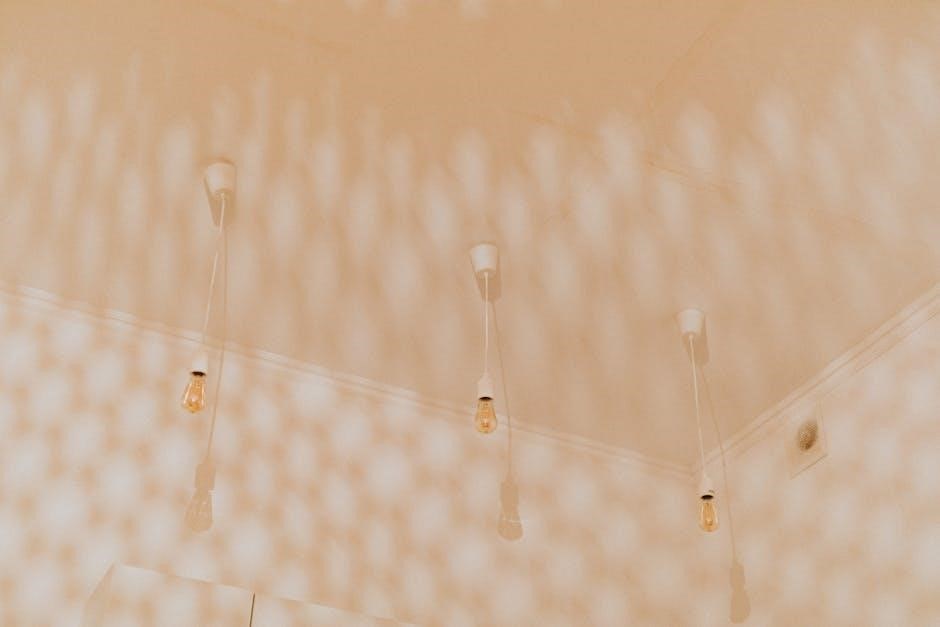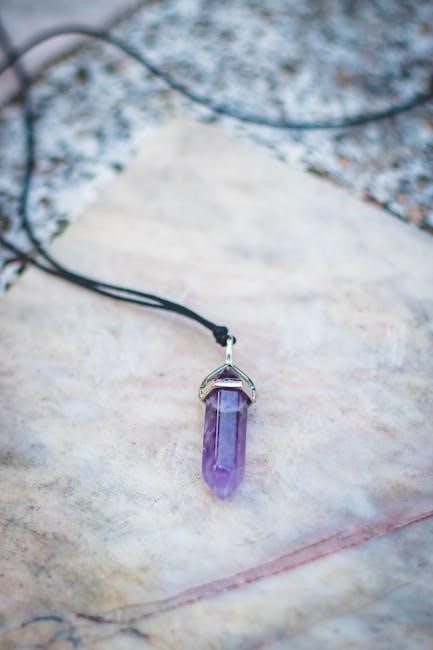Pendant lights are a stylish and functional addition to home decor‚ but selecting the right size can be daunting. This guide helps you navigate sizing‚ spacing‚ and placement to enhance your space’s ambiance and functionality effectively.

Understanding the Importance of Proper Sizing
Proper sizing of pendant lights is crucial for both functionality and aesthetics. A well-sized fixture ensures even light distribution‚ creating a welcoming ambiance while meeting the room’s illumination needs. Incorrect sizing can lead to inadequate lighting‚ making tasks more difficult or creating an uninviting atmosphere.
Furthermore‚ pendant lights that are too large or small can disrupt the balance of a space. For instance‚ oversized fixtures may overwhelm a room‚ while undersized ones may fail to provide sufficient light. Correct sizing enhances the room’s perceived size‚ with proper proportions potentially increasing a room’s perceived size by up to 30%. By prioritizing appropriate sizing‚ you can achieve a harmonious blend of style and functionality in your lighting design.

Key Factors in Choosing Pendant Light Size
Room dimensions‚ ceiling height‚ light coverage‚ and decorative style are essential considerations when selecting pendant light size. Proper sizing ensures optimal illumination and aesthetic balance in any space.
Room Dimensions and Ceiling Height
Room dimensions and ceiling height play a crucial role in determining the appropriate size of pendant lights. Larger rooms with high ceilings can accommodate bigger fixtures‚ while smaller spaces require more compact designs. For instance‚ a pendant light with a diameter of 12-18 inches is ideal for small rooms‚ whereas larger spaces may need fixtures up to 36 inches or more. Ceiling height also influences the hanging height and overall proportions. A general rule is to ensure the pendant light’s diameter is 2.5-3% of the ceiling height. For example‚ in a room with a 10-foot ceiling‚ the pendant should be around 30-36 inches in diameter. Always consider the space’s proportions to achieve a balanced and visually appealing lighting setup.
Light Coverage and Illumination Needs

Light coverage and illumination needs are essential factors in selecting pendant light sizes. The size of the pendant should align with the area it needs to illuminate. For example‚ a kitchen island requiring task lighting may need smaller‚ focused pendants‚ while a dining room needing ambient light might benefit from larger fixtures. The intensity and spread of light also depend on the fixture’s size. A larger pendant can provide broader coverage‚ making it suitable for open spaces or rooms with high ceilings. Conversely‚ smaller pendants are ideal for localized lighting‚ such as over a reading nook or breakfast bar. Ensuring the pendant’s light output matches the room’s functional requirements ensures both practicality and aesthetic appeal‚ creating a well-lit and inviting environment.
Decorative Style and Aesthetic Goals
Decorative style and aesthetic goals play a crucial role in choosing pendant light sizes. The fixture’s size should complement the room’s design‚ ensuring it doesn’t overwhelm or underwhelm the space. For instance‚ modern interiors often favor sleek‚ minimalist pendants‚ while traditional settings might opt for larger‚ ornate fixtures. The material‚ finish‚ and shape of the pendant should align with the room’s decor to create visual harmony. Additionally‚ the scale of surrounding furniture and architectural elements should guide the selection. A small pendant might get lost in a grand‚ high-ceilinged room‚ whereas a large fixture can serve as a striking centerpiece. Balancing form and function ensures the pendant light enhances the space’s beauty and reflects the desired aesthetic‚ making it a seamless addition to the overall design.

Pendant Light Sizing for Specific Spaces
This section explores tailored sizing recommendations for pendant lights in various rooms‚ ensuring optimal illumination and aesthetic appeal in kitchens‚ dining areas‚ bedrooms‚ and living spaces.
Kitchen Island Lighting: Size and Spacing Guidelines
Kitchen island lighting requires careful consideration of size and spacing to ensure functionality and style. Pendant lights over a kitchen island should generally be positioned 28-34 inches above the surface. The size of the pendants depends on the island’s length‚ with options ranging from small (5-10 inches in diameter) for compact spaces to large (20-30 inches) for expansive areas. For multiple pendants‚ spacing should be either 30 inches apart or double the width of each fixture. For example‚ a 12-inch pendant should have 24 inches between them. Proper sizing and spacing enhance task lighting and create a balanced aesthetic. Always measure the island’s dimensions and consider the pendants’ proportions to achieve a harmonious setup. This ensures your kitchen island is both well-lit and visually appealing‚ complementing the room’s overall design seamlessly.
Dining Room Pendant Lighting: Tips for Table Proportions
Dining room pendant lighting should complement the table’s proportions for a cohesive look. Hang pendants 28-34 inches above the table to ensure comfortable illumination. The size of the pendant should relate to the table’s dimensions: for a small table (up to 36 inches wide)‚ use a pendant with a diameter of 12-18 inches‚ while larger tables (over 60 inches) may require pendants up to 24 inches wide. For rectangular tables‚ use multiple pendants spaced evenly‚ with the number of lights depending on the table’s length. Proper spacing ensures even lighting and visual balance. Always consider the room’s overall aesthetic to harmonize the lighting with the decor. This approach creates a warm and inviting atmosphere while maintaining functionality and style.
Bedroom and Living Room Pendant Light Sizes
Pendant lights in bedrooms and living rooms should balance functionality and style. For bedrooms‚ smaller pendants (12-18 inches in diameter) are ideal‚ placed lower for reading or ambiance. In living rooms‚ larger pendants (20-24 inches) can serve as focal points. Consider the room’s size and furniture layout when choosing pendant sizes. In bedrooms‚ position pendants 24-28 inches above nightstands or dressers for task lighting. In living rooms‚ larger pendants can hang 30-36 inches above seating areas to create a cozy atmosphere. Always ensure the pendant’s scale complements the room’s proportions and decor. For a layered lighting effect‚ combine pendants with table lamps or floor lights. Proper sizing enhances both comfort and aesthetics‚ making pendant lights a versatile choice for these spaces. By selecting the right size‚ you can achieve a harmonious and inviting environment in both bedrooms and living areas.
Practical Tips for Pendant Light Placement
Pendant lights should be hung 28-34 inches above surfaces for task lighting. Space multiple pendants evenly‚ 30-36 inches apart‚ to ensure balanced illumination and visual harmony in any room.
Hanging Height Recommendations
Hanging pendant lights at the correct height ensures both functionality and aesthetics. For task lighting above kitchen islands or dining tables‚ pendants should be placed 28-34 inches above the surface. In living areas or bedrooms‚ higher ceilings allow pendants to hang between 30-40 inches above the floor. However‚ in spaces with lower ceilings‚ such as 8 feet‚ pendants should be hung closer to the ceiling to avoid obstructing the view. The general rule is to multiply the room height by 2.5 to 3 to determine the ideal hanging height. Proper placement ensures adequate light coverage and enhances the room’s visual appeal without overwhelming the space.
Spacing Between Multiple Pendant Lights
Proper spacing between multiple pendant lights is crucial for a balanced and visually appealing setup. A general rule of thumb is to space pendants either 30 inches apart or double the width of each fixture. For example‚ if a pendant is 12 inches wide‚ leave 24 inches between each light. This ensures even distribution of light and prevents overcrowding. For larger spaces or longer surfaces like kitchen islands‚ consider the total length and divide it evenly to determine the number of pendants needed. Maintaining consistency in spacing creates a harmonious look and ensures the lighting serves both functional and decorative purposes effectively.
